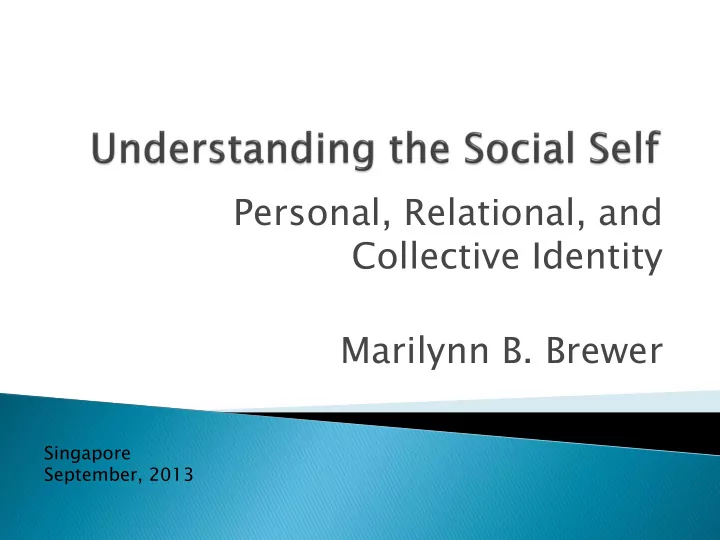

Personal, Relational, and Collective Identity Marilynn B. Brewer Singapore September, 2013
Individual (personal) self Relational (interpersonal) self Collective (group) self
Self System Basis of self-eva valu luati tion on Locus of motivation Personal Interpersonal comparison Individual self-interest Personal welfare and achievements Relational Reflection/assimilation Relational maintenance Other’s welfare and achievements Collective Intragroup assimilation Group maintenance Intergroup comparison Collective welfare and achievements
Pronoun circling priming task (“I, me” vs “We, us” versions) “Who am I” (twenty statement task) individual vs social self-descriptors Value endorsement individualistic vs collectivist values
On TST, females more relational self- descriptors; males more group membership descriptors Females recall more relational emotional experiences; males recall more collective emotional experiences (personal memories) Females better memory for relational events; males better memory for group events (in another person’s diary)
Females more relationship-based trust; males more ingroup (collective)-based trust (Brewer & Maddux, 2005) Females greater willingness to sacrifice own preference for benefit of a close friend; males greater willingness to sacrifice own benefit for the sake of an ingroup organization (Gabriel & Gardner, 1999)
Two types of loneliness (Hawkley, Browne, & Cacioppo, 2005) - Deprivation of relational connectedness (individuals to turn to; feel close to) - Deprivation of collective connectedness (sense of community; inclusion in groups)
Common bond groups (social networks) vs Common identity groups (collective identities) Attachment predicted by different identity needs (Easterbrook & Vignoles, 2012)
Acceptance Flatmate Identification Efficacy Self-esteem Meaning Residence Hall Identification Distinctiveness Easterbrook & Vignoles, 2012
Two types of collectivism (Brewer & Chen, 2007) - relational collectivism - group-based collectivism
Nested groups: Local subgroup vs Superordinate TST individual vs social descriptions Priming relational self greater subgroup loyalty, intergroup bias Priming collective self greater superordinate identity, less intergroup bias
Self System Basis of self-eva valu luati tion on Locus of motivation Personal nal Interpe rpers rsonal nal comparison Individual self-interest Personal welfare and achievements Relational Reflection/assimilation Relational maintenance Other’s welfare and achievements Collecti ctive ve Intrag agroup oup assimilat atio ion Group maintenance Intergr rgroup oup comparison on Collective welfare and achievements
Self-evaluation outcome contrast vs assimilation? Personal vs social (collective) identity salience Minimal group paradigm (overestimators vs underestimators)
Low ingroup identification (low distinctiveness) vs High ingroup identification (distinctive ingroup) Videotaped interview (same sex) -highly accomplished vs mediocre student -member of own group or outgroup DV = self-evaluation on SAQ (academic ability, social competence, attractiveness)
Ingroup Member Outgroup Member Identi tity ty Upward rd Downwar nward Upward rd Downwar nward Cond (Positi tive) ve) (Negati tive) ve) (Positi tive) e) (Negati tive ve Low identif. 5.9 7.5 6.9 6.7 (Individual) Brewer & Weber, 1994
Ingroup Member Outgroup Member Identi tity ty Upward rd Downwar nward Upward rd Downwar nward Cond (Positi tive) ve) (Negati tive) ve) (Positi tive) e) (Negati tive ve Low identif. 5.9 7.5 6.9 6.7 (Individual) High identif. 7.3 6.4 6.2 7.4 (Collective) Brewer & Weber, 1994
Capitalizing on COLLECTIVE identities - motivational value of contributing to group outcomes - shared learning motivation
Recommend
More recommend